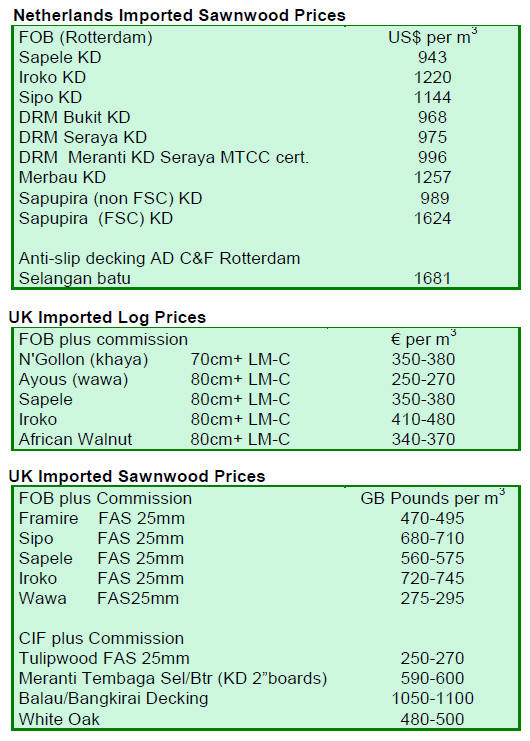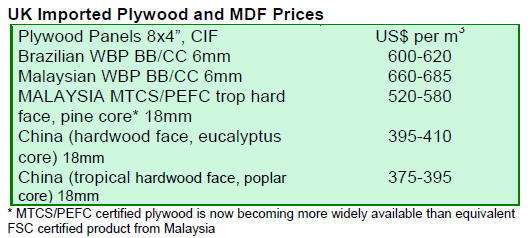|
Report
from
Europe
Changes to the CE marking regime
Significant changes are underway in the CE Marking
regime with potential to impact the European trade in
tropical timbers. The European Commission recently
decided to end early the so-called "co-existence period"
for strength graded structural timber and require
mandatory CE-marking of these products from 1 January
2012. The EC had previously indicated that this
requirement would only be imposed from 1 September
2012.
CPD soon to be replaced by Construction Products
Regulations (CPR).
In a separate development, from July 2013 CE Marking
will become mandatory for the supply of all relevant
constructional products in the four EU countries - the UK,
Republic of Ireland, Finland, and Sweden - which, since
1989, have opted out of mandatory imposition of CE
Marking under the Construction Products Directive
(CPD).
The change will take place when the CPD is replaced by
the new Construction Products Regulations (CPR).
On coming into force in July 2013, the new CPR will also
impose additional environmental standards on construction
products. The CPR states that construction products
should not "exert an exceedingly high impact over their
entire life cycle to the environmental quality nor to the
climate" and there should "be sustainable use of natural
resources".
In the future, manufacturers and assessment bodies will be
obliged to consider whether construction works and
materials make sustainable use of natural resources.
CE Marking applies to construction products sold in the
EU to ensure they meet safety, environmental protection,
health and consumer protection standards required by the
CPD. CE-Marking is applicable to construction products
covered by a European Norm (EN).
New EN standard for construction products
On publication of a new EN standard, the European
Commission will also publish the date at which EU
manufacturers may begin to apply CE marking to the
product concerned - usually nine months after the date of
availability of the standard.
After this date the "coexistence period" begins (usually 12
months), during which manufacturers are free to use the
new EN and apply CE marking, or continue to use the old
national standards without CE marking.
After the period of coexistence, conflicting national
standards must be withdrawn (except, until 2013, in those
EU Member States that have opted out) and all products
must comply with the harmonised EN standard.
Wood-based construction products currently covered by
harmonised EN standards include: strength-graded
structural timber; wood-based panels; solid wood
panelling and cladding wood flooring products; glulam;
prefabricated structural members and wall, floor and roof
elements; structural LVL; and impregnated and fingerjointed
structural timber.
The exact procedures (the so-called Attestation of
Conformance or "AoC" level) to demonstrate conformance
to different EN standards varies. In most instances it will
require the services of a "European Notified Body" which
is a third-party recognised as competent to carry out the
conformity assessment tasks laid down in the standard.
Further information on CPD European Notified Bodies
may be obtained from: http://www.gnb-cpd.eu/index.jsp.
The list of notified bodies can be searched at:
http://ec.europa.eu/enterprise/newapproach/nando/index.cf
m?fuseaction=search.main.
Further details of recent and anticipated changes to the CE
Marking regime are available in a new briefing prepared
by TRADA:
http://www.trada.co.uk/downloads/constructionBriefings/
European%20CPR.pdf
EU Timber Regulation
A series of consultations have been held in recent months
on ¡°implementing regulations¡± for the EU Timber
Regulation (EUTR) which from March 2013 will impose a
prohibition on trade in wood from any illegal source and a
requirement for importers to implement due diligence
systems.
The regulations will establish more detailed requirements
for the risk assessment and mitigation procedures that
must be implemented by importers from March 2013.
They will also establish rules for so-called ¡°Monitoring
Organisations¡±, a concept introduced into the EUTR as a
mechanism to reduce costs of compliance for smaller
European importers and producers.
The final report and recommendations from this series of
consultations prepared by the European Forestry Institute
(EFI) is published at
http://ec.europa.eu/environment/forests/pdf/EUTRFinal_
Report.pdf.
Complexity of the supply chains makes forest origin
identification near impossible
A central concern during consultations was the extent to
which it should be necessary to trace timber to forest of
origin in order to demonstrate a negligible risk of
illegality.
In their publicity material, the European Commission has
tended to emphasise the role of the legislation in
increasing traceability of wood products to source.
However, discussions at consultation meetings highlighted
the complexity of the supply chains that EU operators
must deal with and showed that identification of the forest
of origin would be an impossible task in anything other
than the shortest and simplest of supply chains.
Furthermore, a close reading of the legislative text reveals
that operators are actually under no obligation to identify
the precise forest of origin of timber for each parcel of
timber.
Rather they are required, through their due diligence
systems, to ensure that timber origin can be identified to
the extent necessary to make a reliable assessment of
negligible risk. In some cases this might require
identification of source only as far as a low risk country of
origin.
Progress made towards third party verification
The EFI report notes the considerable progress being made
to develop and expand third party verification and forest
certification systems, which when available will provide
an effective risk mitigation tool.
However the report also cautions against over-reliance on
these mechanisms noting that ¡°only around 10% of the
world¡¯s forests are certified to date, and mostly outside of
the tropics.
Therefore the current global needs for wood cannot be
fulfilled purely from certified forests. Moreover, due to the
lengthy certification process, the associated costs, and the
limited amount of licensed certifiers, this mitigation option
has its restrictions as a quick and extensive mitigation
response at a global scale.¡±
EU SMEs largely unaware of EUTR issues
A key issue identified in the EFI report is the lack of
awareness amongst smaller companies of regulations of
the European Parliament and of the Council laying down
the obligations of operators who place timber and timber
products on the market (the so called EUTR). This, the
report says is likely to be a major obstacle to
implementation.
The report notes that ¡°very few¡± SMEs in Europe have
ever even heard of the EUTR and that ¡°even membership
in a well represented association or federation does not
mean that information [on EUTR] will reach them¡±.
In light of these concerns, the EFI report steers clear of
proposing any far-reaching additional traceability,
documentation or certification requirements on timber
traders.
The report says that: ¡°It is evident that any possible
outcome of the implementation regulation must
acknowledge the variety of affected actors across the
different industry sectors. For example, SMEs have fewer
resources to spend for verifying legality than the big
corporations have.
Therefore, the operators should define their respective Due
Diligence Systems (DDSs) and include the most suitable
tool set for their implementation. Due to the high degree of
different conditions, it is not feasible to develop a fixed
and uniform DDS description which would be applicable
for all operators¡±.
Proposals for specific documentation to be demanded of
overseas suppliers by European importers are limited to "a
signed commitment from the supplier side to deliver legal
wood or wood based products to the operator" and a
¡°signed legal document¡± which would be a ¡°written
contract signed between the parties of the transaction¡± to
include information such as ¡°type and description of the
product, species (either a common name or scientific
name), volume, country of harvest and contact details of
the parties.¡±
It is acknowledged that these documents "will not serve as
a proof for legality¡± but will only provide an assurance of
the suppliers¡¯ policy to avoid illegal wood.
EFI also propose that ¡°depending on the country of origin
and the related risk level, the buyer may ask for more
detailed information on the origin of the timber on a
regional, sub-regional or stand level¡± and propose that this
information be gathered through a standard ¡°information
collection form¡±.
Outsourcing of risk assessment a possible way forward
However the EFI report acknowledges that many
individual operators, particularly SMEs, will not have
time, resources or expertise to undertake reliable
assessment of information collected in these standard
forms.
There will be a need to develop frameworks for
outsourcing of risk assessment to independent experts
better qualified to assess risk and drawing on more
detailed and relevant indicators.
This may involve the establishment of centralised
independent databases categorising levels of risk for
regions or suppliers.
The EFI report also includes recommendations for
Monitoring Organisations (MO). These form a key part of
the European Commission's strategy to overcome the
challenges presented by industry fragmentation.
Rather than having to develop their own due diligence
systems, the EUTR gives European operators the option of
participating in a group due diligence system managed by
an MO.
The original assumption was that European trade
associations and NGOs that are already operating green
procurement codes and systems for member companies
would apply to act as MOs. The role of MOs would be
similar to that of organisations like forestry associations or
consultancies that organise and act on behalf of groups of
smaller forest owners to facilitate their participation in
FSC or PEFC group certification.
The regulatory authorities would benefit because the
private sector would be engaged as active partners in the
regulatory process. Members would benefit from lower
unit costs of compliance. The MOs would benefit through
expanded membership.
However, rather than seeing MOs as facilitating bodies,
EFI¡¯s recommendations assume that MOs should act more
like conformity assessment bodies. As such, EFI proposes
that they should conform to a complex set of ISO
procedures and standards for such bodies.
Requiring MOs to implement such standards might be
costly and make compliance difficult for many
organisations that had been hoping to act as MOs ¨C
notably timber importing associations. It remains to be
seen how this issue will be resolved.
FLEGT VPA process gathers pace
An underlying assumption of the EUTR is that the
majority of tropical timber imported into the EU in the
future will be covered by legality verification systems
established as part of FLEGT Voluntary Partnership
Agreements (VPAs).
The EUTR states that FLEGT VPA licensed timber will be
considered to have been legally harvested and therefore
need not be subject to any further risk mitigation action by
EU operators. Suppliers in countries that are signatories to
a FLEGT VPA with the EU therefore need not fear any
discrimination as a result of the legislation and may have a
competitive edge over suppliers in non-VPA countries.
Recent reports from the FLEGT Unit at the European
Forestry Institute indicate that the VPA process has been
widening its range and gathering pace in recent months.
No country has yet reached the "full implementation and
licensing phase" when each timber product shipped from
the partner country to the EU will have to be accompanied
by a FLEGT license before being given access to the EU
market.
However, there are now 6 countries in the "VPA system
development phase": Cameroon, Central African
Republic, Ghana, Indonesia, Liberia, and Republic of
Congo. During this phase, VPA partners develop systems
and any new capacity required to control, verify and
license legal timber in line with VPA requirements.
The system development phase will only be concluded
following an evaluation demonstrating that the "Legality
Assurance System" (LAS) is fully operational.
An additional four countries are at the "VPA negotiation
phase" and have yet to sign formal VPA agreements:
Democratic Republic of Congo, Gabon, Malaysia, and
Vietnam. Various other countries have not yet entered
formal VPA negotiations but have requested and are being
provided with more information.
These countries include: in Central and South America -
Bolivia, Colombia, Ecuador, Guatemala, Guyana,
Honduras, and Peru; in Asia Pacific - Cambodia, Laos,
Myanmar, Papua New Guinea, the Solomon Islands and
Thailand; and in Africa - Côte d'Ivoire and Sierra Leone.


¡¡ Related News:
|